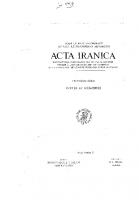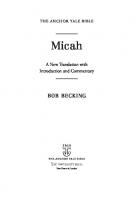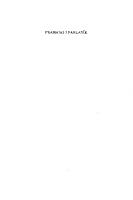The Gāthās of Zarathustra: Edited with Translation, Commentary and a Glossary 9004039023, 9004043993
119 6 10MB
English Pages 387 [396] Year 1975
Recommend Papers

- Author / Uploaded
- Stanley Insler
File loading please wait...
Citation preview
SOUS LE HAUT PATRONAGE DE S.M.l. LE SHAHINSHAH ARYAfvlEHR
ACTA IRANICA ENCYCLOPEDIE PERMANENTE DES ETUDES IRANIENNES FONDEE A L 0CCASION DC 2500' ANNIVERSAIRE DE L.-\ FONDATION DE L EMPIRE PERSE PAR CYRUS LE GRAND 0
0
TROISIEME SERIE
TEXTES ET MEMOIRES
1:11111,1,
Bll3LIOTHEQLE PAHLAVI
E. J. BRILL
TEH ER.•\'.'-!-LI EGE
LEIDEN
,. 't .. Ve.:
I. ··
.- ~~
/;;i,;}-¼t .
~ oGµ
t\ tr~~ 1
ACTA IRANICA TROISIEME SERIE VOLUME I
TEXTES ET MEMOIRES VOLUME I
THE GA THAS OF ZARA THUSTRA by
S. INSLER
I
. i
1975 DlFF\JSION
EDIT10~~
E. J. BRILL
BIBLIOTHEQUE PAHLAVI
LEIDEN
TEHERAN-LIEG E
COMITE INTERNATIONAL Prof. Sir Hi..lroid BAILEY (Grnnde-Brclagnc): Prof. George CA/1.lf.lWN (E.-U.L S. Exe. Prof. Enrico CERl'LLl {ltalie): t S. Exe. Dr T,\R.•\ C1-1..-1:-.D (Incle): Prof. Henri CnRBIN (France): Prof. Jacques Dt·c1-1ESNE-G1111-ur,.11J\ (Belgique): Prof. Namio ECiA,\11 (Jaron): Prof. Dr. Wilhelm E1u.ns (Allcm...ignc); Prof.
S.
Ednrin
B. G.
Garcia
E1tz:t
GA1-1:Rm G(1ME2
(Turquie):
Prof.
Richard
ETTINGH,\l.1SEN
{E.-l.;.).
(U.R.S.S.): Prof. Roman GHIRSH/l.1AN (Frunce): S. E:\c. (Esp.ignc): Prof. JilnCls H -\R/1.I•\ TTA t Hong.rie). Prnf
Acud. Prof.
Dr.
Wuhhcr H1r,.;7. (Allt:rnagnc): Prof. Yahya AL-1'-H-\51-IMI {Egyr1c): S Em. C.1rd. Dr. Franz KONlti !Autrichc); Prof. Georg MoRCiE\.STIF.RNE (NorvCgcl: + Prof_ Henrik S. NYIIF.l Gutcnht:rg. J\•1.iycnce. Universitt! tic LiCgc. PL.ice du 20 uollt 16, 8 4000 UCgc.
ISBN 90 04 03902 3 90 04 04399 3
© 1975 hy Bihliothi!quc Pahlal'i. Tehran-lh~gl' All rigl1fs rcserv('d. No pan r~f this hook may ht• reproduced or lranslated in cmJ' /nrm. hy prinl. ph01opri111. mhn~fi/m, micnificlw or any oilier means ,,·itholll ll'rirten permission from tht' puhlisht•r PRINTED IN BELGILl,\1
For Paul Thieme l'idvd /,qs /wciscifrli
y5 nui 111q0ranqm pa0o si!iaf ya0ii volnl urvlijil mwwl)hii
yascii m/Ji a.frl daxJaf tc/111 paourvyqm hugarabq111 al~rii \'ahmii.i stiiwi!cli
aesqm vahi!itanqm srm·al]hqm ii t5m ya0Jnam 1,aeda_riimahi
CONTENTS Introduction The text The translation The commentary Yasna 28 Yasna 29 Yasna 30 Yasna 31 Yasna 32 Yasna 33 Yasna 34 Yasna 43 Yasna 44 Yasna 45 Yasna 46 Yasna 47 Yasna 48 Yasna 49 Yasna 50 Yasna 51 Yasna 53 Commentary Addenda Relerences . Abbreviations Complete glossary to the gathas Index locorum . Index verborum
\-;.,
.
f\.-,~j/~i
3
20 21 24 28 32 36 44 50 54
60 66 74
so 88
90 94 98 102 I 10 114
327 335 338 339 365 375
INTRODUCTION Because of their relative brevity and the almost total lack of other earlier or contemporary works of Old Iranian literature, the Gathas of Zarathustra are truly a text bound with seven seals. Much of the grammar, the vocabulary and the syntax encountered in these lyrics remains unique in relationship lo the language appearing in the later texts assembled in the Avesta. Likewise, the prophet's hymns are laden with ambiguities resulting both from the merger of many grammatical endings and from the intentionally compact and often elliptical style which characterizes his poetic art. The higher level question of the interpretation of the Gathas· content, frequently expressed in metaphoric and allegorical terms, is even more problematic. The noted literary isolation or the text within the ancient period has excluded the possibility of fixing a true position to the prophet's theology within the preceding developments of [ranian religion. Similarly, there exist no early analytical commentaries of the Zoroastrian tradition, written in the wake of Zarathustra's innuence, which could present in detail the meaning or his message lo the community of his adherents. And finally, the mechanical arrangement of the Gathas within the Avesta according to their metrical schemes has effaced all certain chances of even following the prophet·s intellectual evolution within his own fragmentary works. Thus, lo anyone struggling with these lyrics, the Guthus truly appear to be a book of riddles. But like all riddles, the problems encountered within the Gathiis beg to be solved. and many have been solved. Most of the grammatical forms have been puzzled out through the help of the related Indian Rigveda, which has also provided the source for establishing much or the fundamental vocabulary of Zarathustra·s lyrics. This literary monument of India has likewise revealed a number of stylistic figures and syntactic conventions which have aided in the interpretation of various passages in the prophet "s hymns. And the Rigveda has moreover l"urnished a textual counterpart against which the dominant themes ofZarathustra"s teachings can be compared and judged. Other progress in understanding this ancient Avestan text has been achieved, primarily through the efforts of Humbach, by the careful internal analysis of recurrent literary devices and repeated expressions within the
2
INTRODUCTION
language or the Gathas. For. besides establishing without doubt the unity or composition or these lyric poems. this type or philological study has been extremely helpful in revealing several basic techniques or the syntactic and expressive organization of the prophet"s words. Yet many riddles still persist which prevent us from grasping unequivocally Lhe meaning of Zarathustra·s poetry. The transmitted 1ex1 of the GCTtbiis has sulTerecl profound corruption in a few important passages which escape assured reconstruction. Furthermore. various items or the vocabulary or these lyrics remain unknown: others. particularly those which appear 10 have connections wilh the Rigwdic vocabulary. continue 10 be a source of dispute owing to the possibility of either a cli!Terence in meaning between cognate words or a false basis or comparison. Bui on:rshaclowing all the difriculties inherent in properly understanding the G,1thils is the problem of disentangling the intricacies of their syntax. Because. as long as little certainty exists in the cstablisl1men1 of dcl1ni1c rules for interpreting the various possibilities or srntactic coordination within the special eloquence 01· Zarathustra ·s p,1e1ry. there can be no assurance thul the translation or a given pt1S$









